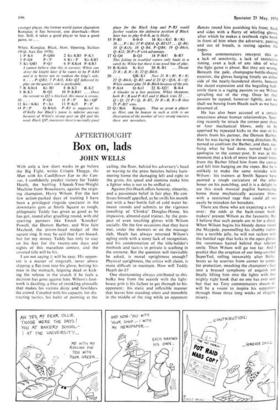Chess 492
PHILIDOR
A. R. Gooderson (3rd Prize, acrs, 1954). White to play and mate in two moves; solution next week.
Solution to No. 491 (Vladimirov 1k5r/Ip5p/ 1B5K/32/7Q): Q-R4! A. 1 ... R-Ktl; 2 Q-R2ch, K-R1; 3 Q-R2ch, K-Ktl; 4 Q xR mate. B I R-KB1; 2 Q-Kt3 ch, K-R1; 3 Q-R3ch etc.
C 1 . . . R-K I; 2 Q-B4ch, K-R1; 3 Q-R4ch.
D 1 . . . K-RI; 2 K-Kt7, R-QB1; 3 Q-R4ch etc.
E 1 . . . K-BI; 2 Q-K7, K-Kt1; 3 Q-K5ch. Extraordinarily ingenious composition.
A player who has advanced very rapidly in recent years and, without for some reason attracting very much attention, has now established hunself as one of the foremost players in the world is the twenty-six year old Czech grandmaster Vlastimil Hort. He confirmed this position when, the youngest player on either side, he defeated Polugayevsky 21/11 on board 4 in the recent USSR V The Rest match. Looking around for a good recent example of his skill my eye was immediately caught by the following game against a still
younger player, the former world junior champion Kumjica; it has however, one drawback—Hort lost. Still, it takes a good player to lose a good game, so.
White, Kurajica. Black, Hort. Opening, Sicilian (Wijk Aan Zee 1970).
1 P-K4 P-Q134 2 Kt-KB3 P-K3 3 P-Q4 PxP 4 Kt x P Kt-KB3 5 Kt-QB3 P-Q3 6 P-KKt4 P-KR3 1 cannot believe that this is correct; White can drive the knight later if he wants to by P-KR4 and it is better not to weaken the king's side. 6 . . . P-QR3; 7 P-Ku, KKt-Q2 followed by play on the queen's side is preferable.
7 R-KKH Kt-B3 8 B-K2 B-K2
9 B-K3 B-Q2 10 P-KR4I ... Once the retreat to Q2 is blocked, this move is strong.
10. . . P-Q4 11 PxP Kt xQP 12 KtxKKt PxKt 13 P-Kt5 PxP
14 PxP Q-R4ch P-R3 is suggested by O'Kelly but Black's game is inferior anyway because of White's strong post on Q4 and the weak Black QP; moreover there is no really good
place for the Black king and P-R3 would further weaken the defensive position if Black later has to play 0-0-0, as is likely.
15 P-B3 0-0-0 16 Kt x Kt! B x Kt /6... P x Kt; 17 P-QKt4, Q-B2 (17 . Q-R6; 18 Q-Kt3); 18 Q-R4, P-QB4; 19 Q-R6ch, Q-Kt2; 20 PxP with advantage.
17 Q-Q4 B-Q3 18 P-R4! B-R7 This _fishing in troubled waters only leads to a catch by White but there is no good line of play.
19 B-Kt4ch K-Ktl 20 R-R1 ... Threat
21 Rx B, Rx R; 22 Q-B4ch.
20. . . QR-K1 Now 21 R x B?, R x R;
22 Q-B4ch, Q-B2; and if 23 Qx Qch, K x Q; White cannot play 24 B-B4ch because of the pin.
21 P-Kt4 Q-Kt3 22 K-Q2! B-K4 A blunder in a lost position. White threatens both Rx Band P-Kt5 and if Black tries 22 . . Qx Q; 23 Px Q, R-R5; 24 Rx B, Rx B then 25 P-B3! wins.
23 Q x Bch Resigns. That as great a player as Hod can be beaten in such a style is an illustration of the number of very strong masters there are nowadays.



































 Previous page
Previous page